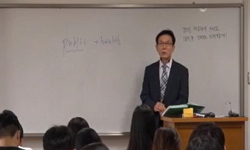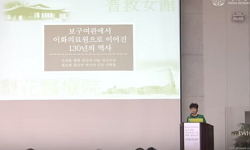This article attempts to review the reality of rural health care in Korea from the 1960s to the 1980s by analyzing the Daegok Diary. There has been two myths about rural healthcare. One is that the absence of institutional medicine was replaced by fol...
http://chineseinput.net/에서 pinyin(병음)방식으로 중국어를 변환할 수 있습니다.
변환된 중국어를 복사하여 사용하시면 됩니다.
- 中文 을 입력하시려면 zhongwen을 입력하시고 space를누르시면됩니다.
- 北京 을 입력하시려면 beijing을 입력하시고 space를 누르시면 됩니다.



어느 시골 농부의 ‘반의사’(半醫師) 되기: 『대곡일기』로 본 1960-80년대 농촌 의료 = A Farmer Becoming a Quasi-doctor: The Daegok Diary and Rural Healthcare from the 1960s to the 1980s
한글로보기https://www.riss.kr/link?id=A105972986
-
저자
박승만 (연세대학교)

- 발행기관
- 학술지명
- 권호사항
-
발행연도
2018
-
작성언어
Korean
-
주제어
rural healthcare ; Daegok Diary ; quasi-doctor ; Health Insurance ; family medical books ; folk medicine ; Western medicine ; 농촌 의료 ; 대곡일기 ; 반의사 ; 의료보험 ; 가정의학서 ; 민간의료 ; 서양의학
-
등재정보
KCI등재,AHCI,SCOPUS
-
자료형태
학술저널
- 발행기관 URL
-
수록면
397-446(50쪽)
-
KCI 피인용횟수
1
- 제공처
- 소장기관
-
0
상세조회 -
0
다운로드
부가정보
다국어 초록 (Multilingual Abstract)
This article attempts to review the reality of rural health care in Korea from the 1960s to the 1980s by analyzing the Daegok Diary. There has been two myths about rural healthcare. One is that the absence of institutional medicine was replaced by folk medicine, which could be identified with folk remedies or shamanic healing distinguished from Western medicine.
This is a frame that understands institutional and Western medicine as a pair and folk medicine and traditional medicine as another. Another popular belief is that rural healthcare had remained almost nonexistent, and only dramatically improved after the Regional Health Insurance was implemented. Of course, some claim that the Regional Health Insurance was disadvantageous to farmers, but it is generally understood that there was an absence of government policy regarding medical care.
The Daegok Diary, telling many aspects of rural life, is a good source to reflect on these common notions. Unlike other farmers’ diaries, the diary of Shin Kwonsik contains a wealth of medical culture records because he chose unique ways to cure his and neighbors’ illnesses by himself. It can be summarized as the life of “quasi-doctor”. Shin was distinguished from quacks in that he practiced as an intellectual in the village rather than as a profession, and that he learned official medical knowledge and recognized the difference between a licensed physician and himself. Also, he was different from doctors because of the lack of a medical license and the limited range of diseases that he could treat.
The life of quasi-doctor shows the social structure of rural areas in Korea from the 1960s to the 1980s. The reality of rural healthcare can be summarized in two ways. First, the medical vacuum was filled by civilian efforts. There was virtually no institutional healthcare in rural areas, but the government did little to improve the situation . The policy of sending doctors to the countryside proved to be ineffective, and the community doctor system did not work properly. Health Insurance was also a system for city workers rather than farmers. In the late 1970s, the situation only slightly improved due to reasons unrelated to the government policy regarding rural healthcare. These were improvements in traffic conditions and the increasing popularity of private insurance, which improved the physical and economic accessibility to medical institutions.
Second, Western medicine had become a part of folk medicine.
Those who could not go to a hospital utilized Western medicine, which had penetrated the folk medical culture. When people were sick, they bought Western drugs from pharmacies, drug dealers, and sometimes quacks. The knowledge of Western medicine also spread widely, with family medical books such as Million People’s Medicine as the medium.
These two characteristics show that the existing myths that regard the absence of government policy as that of medical care and interpret the medical vacuum as the prevalence of folk remedies and shamanic healing are far from the truth. From the 1960s to the 1980s, gaps in institutional medicine was filled by Western medicine which had become part of the folk medicine already, and the accessibility of institutional medicine was improved through civilian efforts.
Of course, the Daegok Diary shows more than the social structure of rural areas. It also reveals a lot about the man who wrote it, Shin Kwonsik.
Unlike the others, Shin chose to become a quasi-doctor because of his separation from the tradition and his desire to learn. He grew up alone without parental care and later moved to Seoul by himself. This meant a break with the tradition. He joined the army in the wake of the Korean War and learned how to give injections there. After he was discharged, he devoured many books and newspapers including Million People’s Medicine. In short, the existence of a quasi-doctor like Shin was the result of the combination of the absence of i...
참고문헌 (Reference)
1 박윤재, "해방 전후 귀속 제약회사의 동향과 한국 제약업" 한국근현대사학회 (78) : 231-260, 2016
2 신규환, "해방 이후 약무행정의 제도적 정착과정: 1953년 「약사법」 제정을 중심으로" 대한의사학회 22 (22): 847-878, 2013
3 양정필, "한말-일제 초 근대적 약업 환경과 한약업자의 대응- ‘매약’제조업자의 등장과 성장을 중심으로 -" 대한의사학회 15 (15): 206-186, 2006
4 박윤재, "한말 일제 초 대형 약방의 신약 발매와 한약의 변화" 한국역사연구회 (90) : 239-265, 2013
5 문옥륜, "한국의료보험의 발전과 역사적 함의" 34 (34): 1997
6 경제기획원, "한국의 사회지표" 경제기획원 1978
7 문화공보부 문화재관리국, "한국민속종합조사보고서, 제1-12권" 문화공보부 문화재관리국 1969
8 조홍식, "한국농촌사회의 복지문제" 2 : 1992
9 연세의사학, "한국 진단검사의학의 개척자, 이삼열" 13 (13): 2010
10 이꽃메, "한국 보건진료원 제도의 시작" 4 (4): 2009
1 박윤재, "해방 전후 귀속 제약회사의 동향과 한국 제약업" 한국근현대사학회 (78) : 231-260, 2016
2 신규환, "해방 이후 약무행정의 제도적 정착과정: 1953년 「약사법」 제정을 중심으로" 대한의사학회 22 (22): 847-878, 2013
3 양정필, "한말-일제 초 근대적 약업 환경과 한약업자의 대응- ‘매약’제조업자의 등장과 성장을 중심으로 -" 대한의사학회 15 (15): 206-186, 2006
4 박윤재, "한말 일제 초 대형 약방의 신약 발매와 한약의 변화" 한국역사연구회 (90) : 239-265, 2013
5 문옥륜, "한국의료보험의 발전과 역사적 함의" 34 (34): 1997
6 경제기획원, "한국의 사회지표" 경제기획원 1978
7 문화공보부 문화재관리국, "한국민속종합조사보고서, 제1-12권" 문화공보부 문화재관리국 1969
8 조홍식, "한국농촌사회의 복지문제" 2 : 1992
9 연세의사학, "한국 진단검사의학의 개척자, 이삼열" 13 (13): 2010
10 이꽃메, "한국 보건진료원 제도의 시작" 4 (4): 2009
11 평택군기획실, "평택군 통계연보" 평택군 1962
12 지역문화연구소, "평택 일기로 본 농촌생활사: 평택 대곡일기, I-III" 경기문화재단 2007
13 김영미, "평택 대곡일기를 통해서 본 1960~70년대 초 농촌마을의 공론장, 동회와 마실방" 한국사연구회 (161) : 383-416, 2013
14 이문호, "최근 한국의 질병 변천" 32 (32): 1989
15 이규식, "일제의 농촌 침탈과 농촌위생연구소" 10 (10): 2001
16 송달옥, "일부 농촌지역의 민속의료이용에 관한 조사" 11 (11): 1974
17 손현주, "일기연구의 방법, 현황, 그리고 응용" 지식과교양 2017
18 문만용, "일기로 본 박정희 시대의 ‘농촌 과학화’" 한국지역사회학회 21 (21): 25-43, 2013
19 송건용, "의료보험이 의료이용양상과 의료균점에 준 효과분석" 8 (8): 1988
20 의료보험연합회, "의료보험의 발자취: 1996년까지" 의료보험연합회 1997
21 국립민속박물관, "위도의 민속: 상, 제례, 장제, 민간의료, 민요, 설화편" 국립민속박물관 1985
22 한명렬, "우리나라 일부농촌지역의 민속의료에 관한 조사연구" 5 (5): 1964
23 허정, "우리나라 농촌의료에 관한 사회의학적 연구" 3 (3): 1962
24 김영미, "어느 농민의 생활세계와 유신체제" 한국근현대사학회 (63) : 275-306, 2012
25 한미선, "심판대에 오른 의료보험 10년" 1988
26 송탄시, "송탄시 통계연보" 송탄시 1982
27 왕연, "새마을운동과 1970년대 한국 농촌사회의 변화 연구" 건국대학교 2016
28 보건사회부, "보건사회통계연보" 보건사회부 1964
29 보건사회부, "보건사회백서: 국민보건과 사회복지" 보건사회부 1965
30 보건사회부, "보건사회 행정의 실적과 전망: 보건사회행정백서" 보건사회부 1971
31 김상문, "백만인의 의학" 동아출판사 1959
32 신동면, "박정희의 맨얼굴" 시사IN북 2011
33 조석곤, "박정희의 맨얼굴" 시사IN북 2011
34 윤홍식, "박정희 정권시기 한국 복지체제: 반공개발국가, 복지국가의 기능적 등가물" 한국사회정책학회 25 (25): 195-229, 2018
35 원보영, "민간의 질병인식과 치료행위에 관한 의료 민속학적 연구" 민속원 2010
36 "매일경제"
37 "동아일보"
38 박경숙, "농어천의료보험제도가 의료서비스이용에 미친 효과분석" 한국보건사회연구원 1990
39 안승택, "농민의 풍우(風雨) 인식에 나타나는 지식의 혼종성: 『평택 대곡일기(1959~1979)』를 중심으로" 비교문화연구소 21 (21): 249-290, 2015
40 이준희, "농민 수탈하는 농촌의료보험" 1991
41 "국회회의록"
42 "국가재건최고회의회의록"
43 "관보"
44 "경향신문"
45 경기도, "경기통계연보" 경기도 1981
46 신영전, "건강보험 통합 쟁취사" 141 : 2010
47 국립문화재연구소, "『한국민속종합조사보고서』, 제26권 민간의약" 국립문화재연구소 1996
48 이상의, "『조선의 농촌위생』을 통해 본 일제하 조선의 농민생활과 농촌위생" 역사교육연구회 (129) : 227-259, 2014
49 "『박정희대통령연설문집』, 제2집: 제5대편"
50 "『박정희대통령연설문집』, 제1집: 최고회의편"
51 안혜경, "‘평택일기’를 통해 본 일생의례와 속신" 실천민속학회 18 : 167-199, 2011
52 이송순, "1970년대 한국 대중의 정치의식과 ‘반공국민’으로 살아가기 - 개인일기 4종을 통해 본 1970년대 대중의 정치의식" 민족문화연구원 (71) : 41-88, 2016
53 박윤재, "1940-60년대 농촌위생연구소의 설립과 활동" 한국역사연구회 (72) : 253-287, 2009
동일학술지(권/호) 다른 논문
-
15-16세기 조선 의학 관료의 신분 변천: 양성이씨 세전 사례를 중심으로
- 대한의사학회
- 박훈평
- 2018
- KCI등재,AHCI,SCOPUS
-
호남 지역의 위생·의료문제: 일제 ‘위생규율’의 식민지 지역사회에 대한 침투와 한계
- 대한의사학회
- 마츠모토다케노리
- 2018
- KCI등재,AHCI,SCOPUS
-
- 대한의사학회
- 천명선(CHUN Myung-Sun)
- 2018
- KCI등재,AHCI,SCOPUS
-
- 대한의사학회
- 마쓰모토 다케노리(松本武祝)
- 2018
- KCI등재,AHCI,SCOPUS
분석정보
인용정보 인용지수 설명보기
학술지 이력
| 연월일 | 이력구분 | 이력상세 | 등재구분 |
|---|---|---|---|
| 2023 | 평가예정 | 해외DB학술지평가 신청대상 (해외등재 학술지 평가) | |
| 2020-01-01 | 평가 | 등재학술지 유지 (해외등재 학술지 평가) |  |
| 2011-01-01 | 평가 | 등재학술지 유지 (등재유지) |  |
| 2009-01-01 | 평가 | 등재학술지 유지 (등재유지) |  |
| 2006-07-07 | 학술지명변경 | 외국어명 : 미등록 -> Korean Journal of Medical History |  |
| 2006-01-01 | 평가 | 등재학술지 선정 (등재후보2차) |  |
| 2005-05-30 | 학술지등록 | 한글명 : 의사학외국어명 : 미등록 |  |
| 2005-01-01 | 평가 | 등재후보 1차 PASS (등재후보1차) |  |
| 2003-07-01 | 평가 | 등재후보학술지 선정 (신규평가) |  |
학술지 인용정보
| 기준연도 | WOS-KCI 통합IF(2년) | KCIF(2년) | KCIF(3년) |
|---|---|---|---|
| 2016 | 0.81 | 0.81 | 1.04 |
| KCIF(4년) | KCIF(5년) | 중심성지수(3년) | 즉시성지수 |
| 0.97 | 0.91 | 2.084 | 0.2 |




 KCI
KCI DBpia
DBpia





